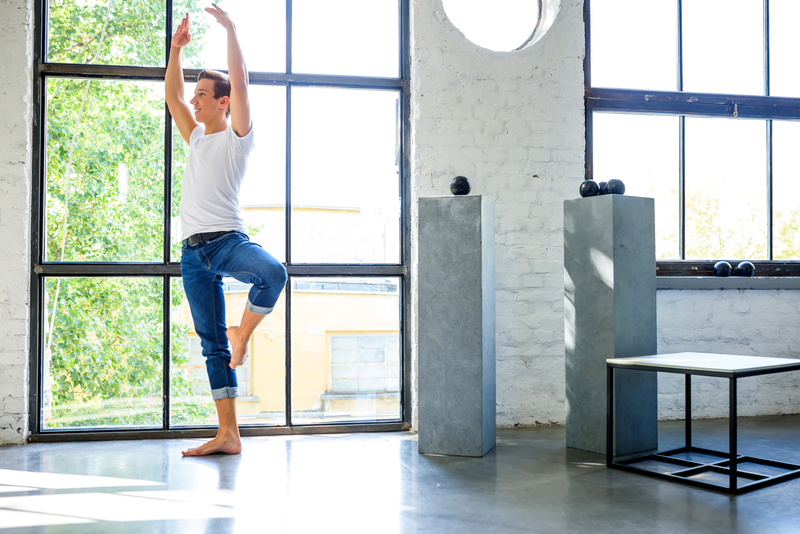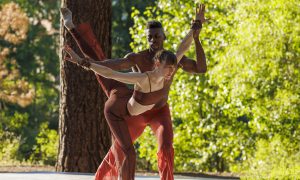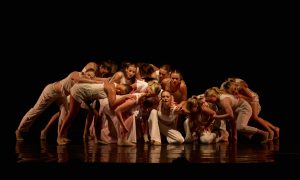While it’s easy to get bogged down in the midst of the global pandemic we are facing, the dance world has responded to the unprecedented challenges sweeping the world with a renewed sense of creativity, solidarity and generosity. I’ve never been more proud to be a dance artist or felt more connected to the dance community, and all this dancing alone together has left me with a sustained pleasure in movement that I haven’t felt since early childhood. I am dancing in front of the open refrigerator door again, sliding around the living room in my socks to that intuitive mental rhythm, staring into my dog’s eyes as I kick-ball-change toward her, watching her tail wag, fascinated that energy is translatable across species, across the borders of nations, even detectable through the various wires that power those sacred Zoom sessions.
So while I can’t wait to be back in the studio rolling in the sweat of familiar strangers, I hope that the dance world will retain its newfound spirit. I must admit that I am afraid of the return to “normal” that most seem to be scrambling for. I am afraid that the bustle of daily life, the swiping of plastic and the dings of cash registers, will steal what we have only just begun to discover. Not sure what radical, humanizing changes I’m talking about? Let me explain.
#1. Free/Donation-based/Pay-what-you-can classes
As most dancers (and parents of dancers) know all too well, it is nearly impossible to earn as much dancing as you spend learning and refining the craft itself. From the cost of training throughout childhood to attending a conservatory to taking classes and participating in intensives to physical therapy and other wellness practices to living in a major city, dance is expensive. Add to that the minimal payment most dancers receive, and it’s easy to see why many professional dancers have to supplement their incomes with a whole gamut of side jobs: babysitting, dog-walking, waiting tables, the list goes on.
Every dancer knows that it is essential to keep up with their technique, to continue learning new methodologies and styles, to constantly research and cultivate the capabilities of their body and so on, but transforming knowledge into consistent action is arduous and costly. Most classes are around $20 each, which adds up quickly. While some institutions are charging similar amounts for online classes, most virtual classes motivated by social distancing guidelines are significantly more affordable even without the associated elimination of transportation costs to and from class. (Plus, the environmental benefits are worth considering.) Some of them are even free (including Break the Floor LIVE hosted by Travis Wall!). While this seems like a novel concept, it is really a reminder that we all have something unique and valuable to offer, regardless of whether or not someone is willing to pay an arm and a leg for it.
The result? Is it a perfect system? Can I get as much out of a class in my room where the music is behind the teacher’s counts by two seconds and my cat keeps walking by at inopportune moments as I can in the studio? Presumably not. But can I get more out of it than a day spent trying to make ends meet with a schedule that’s too tightly packed to make it to class more than once every two weeks if I can afford it? Absolutely. What’s more, donations are flying. Gaga Online, for example, shattered its one-month donation goal, and money is going directly to the teachers.
In addition to increasing accessibility, Zoom classes allow dancers to connect to artists from around the world. Just yesterday, I took class with friends in multiple countries whom I met at a dance program in Israel. Just last week, I learned repertory from an international artist with more than 200 other dancers from across the globe. Towing the line between virtual and in-person experiences should not be taken lightly when quarantine ends.
#2. Availability of dance videos
It is notoriously difficult to find full-length dance works online. That has begun to change over the course of the last few months, and while the latent fear of choreographic plagiarism still lurks, the public availability of dance works on the internet is an important step in the direction of approachability. Being less precious about the work we produce and replacing that preciosity with an eagerness to share opens dance to a wider audience that includes people who would never think to spend their time and money at the theater watching something they vaguely think of as swanky and esoteric. Maybe, just maybe, after seeing a few pieces from the comfort of their couches, these audiences might venture into the theater. The availability of seminal dance pieces online is also an invaluable educational tool to dancers, not to mention a source of inspiration.
#3. Creative collaborations
An outpouring of unconventional collaboration has sprung out of shelter-in-place orders. From exquisite corpse improvisation compilations to online dance festivals to large-scale, elaborate interdisciplinary compositions, there are inventive collaborations skulking behind every click. Just the other day I made a short phrase from a series of six emojis for a compilation that will be posted on social media.
Zoom performances have also swept the internet, and while they are rarely as seamless as live performances, there is a genuine sentiment of refreshing realism about them, and they also give you a reason to change out of your pajama top if not your pajama bottoms. Not only are dance communities all over the world banding together, but various arts communities are making new connections with each other, not merely crossing disciplinary boundaries, but softening them, bringing the common ground of all artists into frame.
In short, yes, let’s reopen the “real” world when the times come with enthusiasm and delight. Let’s pack the theaters, let’s sweat up the studios, let’s demonstrate our resilience in style. But let us also etch the coronavirus outbreak into our collective memory. Let us remember the why in the midst of how much.
By Charly Santagado of Dance Informa.















